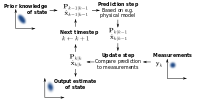
Photo from wikipedia
We present a new way of recursive image filtering called the two-way recursive filtering. Different from most recursive image filters that pose the 2D image filtering as iterative 1D row/column… Click to show full abstract
We present a new way of recursive image filtering called the two-way recursive filtering. Different from most recursive image filters that pose the 2D image filtering as iterative 1D row/column filtering, we consider the propagation on a 2D image plane directly. To compute the filtered value of a pixel, our method takes feedback from two neighboring pixels, one connected horizontally and the other connected vertically. In this way, the proposed filter has a dense receptive field, leading to fewer iterations needed to filter an image. We demonstrate its ability in high-quality edge-aware image smoothing without compromising the efficiency compared to 1D filters. We show that the proposed filter can also be formulated as a layer in a deep neural network. The feedback coefficients of the recursive filter are learned via backpropagating through the proposed filter. Our experiments on segmentation refinement show that our method produces favorable results against the three-way connection scheme in a previous segmentation refinement algorithm. To the best of our knowledge, this is the first work that explores the two-way pixel connectivity for recursive filtering.
Journal Title: IEEE Transactions on Circuits and Systems for Video Technology
Year Published: 2021
Link to full text (if available)
Share on Social Media: Sign Up to like & get
recommendations!